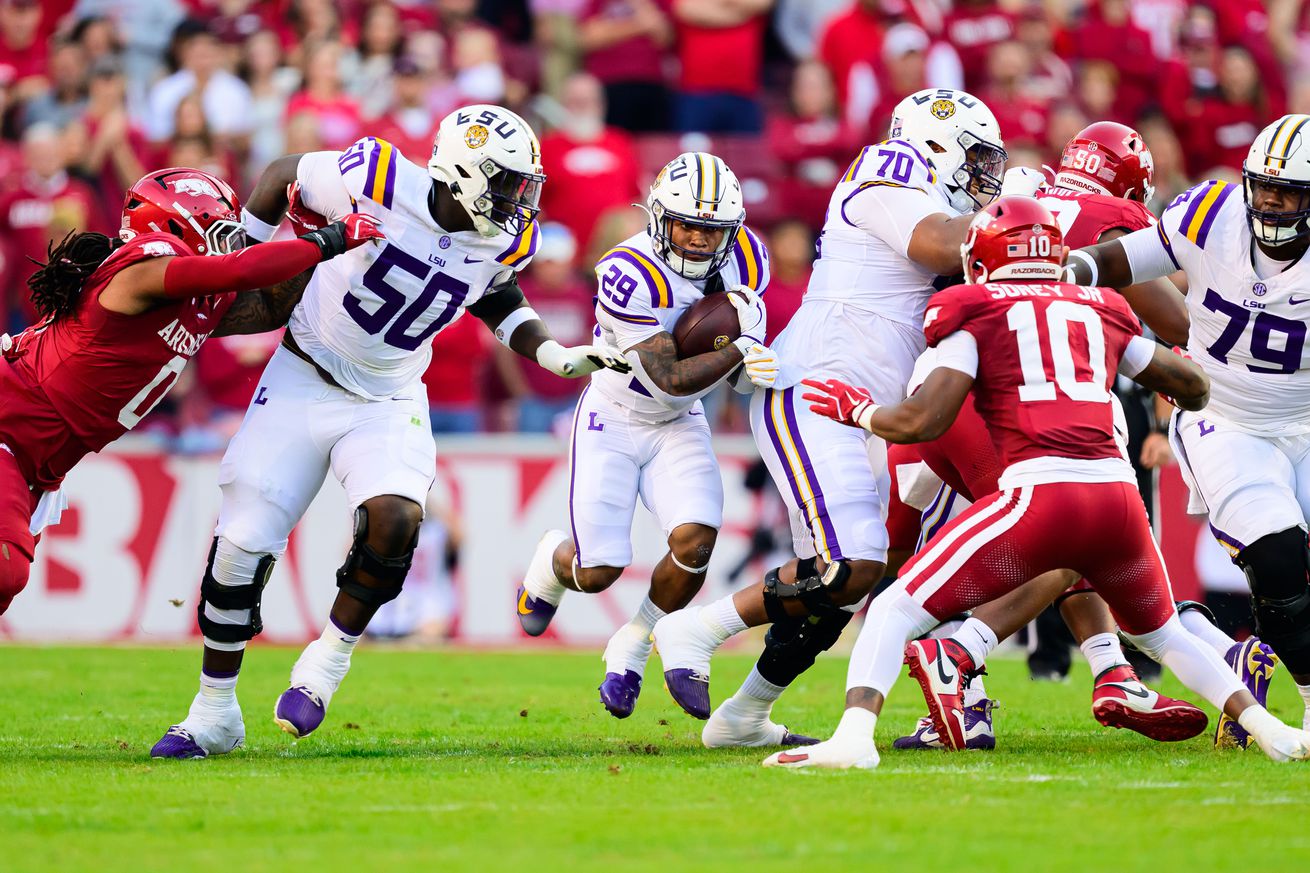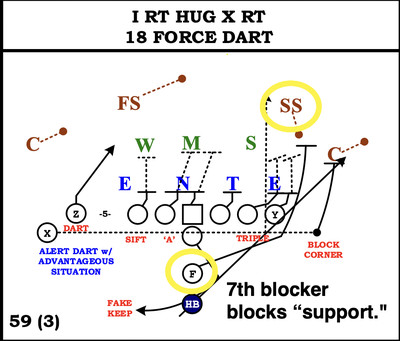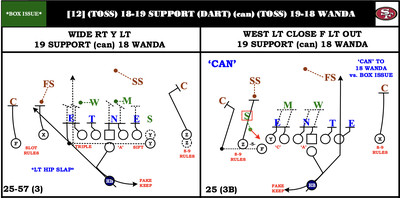
LSU’s search for identity in the run game stretches into Week 8
As we all know by now, LSU’s run game was built on the legs of (Rookie of the Year frontrunner) Jayden Daniels and the ability of (will probably finish 2nd and 3rd) Malik Nabers and Brian Thomas Jr to force safeties way out of the box. With nobody left inside, it was easy for them to run the football with nothing but inside-zone. Now, the deck has been shuffled and LSU is having a lot of problems with its new hand. They couldn’t keep running inside-zone because the QB isn’t a threat to keep and they can’t control box count, and they have tried/are struggling to teach the OL to successfully block counter. LSU used this week to try something totally different that they’d only used sparingly: outside-zone.
— MTFilmClips (@MTFilm) October 22, 2024
Unlike counter or inside-zone, OZ is a horizontal run built on athleticism along the front rather than physicality. Despite the similarity in assignment determination principles to inside-zone (zone blocking with double teams and climbs), the technique is different. The line is trying to get across the face of their counterparts and cut them off backside creating a lane for the RB to cut back if the perimeter is closed (this is part of why it’s not great from the offset-shotgun like this, but more on that issue later). If they can’t get across their guy, it works just as well to run them wide to the frontside and allow the RB to cut it behind them. This can even result in the whole front washing everything frontside with the back winding it all-the-way behind the backside tackle like in the above clip. This play from 4-wide gives a good isolation look at what the offensive line is doing, which remains more or less the same with every variation of the play.
— MTFilmClips (@MTFilm) October 23, 2024
Now let’s look at some of the other key blocks in the play. There are basically two additional blocks that need to be made in/around the formation. First, you need the TE, if he is to the side of the run, to take any immediate, on-ball edge defender aligned outside of him, if there’s nobody, he helps the OT on a double-team and climbs to the second level to take the first guy there (covered/uncovered rules). His technique is to pin him inside or turn him out/upfield like is done here. Arkansas shows slot pressure so that guy becomes the immediate edge, which puts Mason Taylor on him. Nussmeier alerts Taylor to the slot pressure and he takes care of it.

The other guy that needs to be blocked inside the formation is the extra guy who can enter the box. This is usually one of the Safeties (ignore the CBs and backside S as they aren’t considered people you need to really block in the box) but it can be a slot defender. This guy is known as the “support” defender, that one guy you can’t block with the 5 OL and TE. This guy is usually blocked by whomever the 7th blocker is. That’s either a FB, 2nd TE, or one of the receivers, depending on what those other guys are doing. In this case, that’s slot WR/Flex TE Trey’Dez Green. He initially has the slot defender when he appears to be off the ball, which would make him the support defender and, because the TE is free to climb to he SS, make that guy functionally the SAM LB (like the illustration). When the slot shows blitz and becomes, again in the eyes of the blocking scheme, the defensive end, they trade and Green has the new support defender, the SS. That’s a lot of detail, but you can see in the illustration from the 49ers playbook how this works visually. It’s fairly intuitive who blocks whom when you understand the base rules of the OL and who they account for. as a rule of thumb, just think of the support defender as the first guy to the outside, from the 2nd or 3rd level of the D, to the side of the run.
— MTFilmClips (@MTFilm) October 22, 2024
Just like with counter, from a technique perspective, LSU’s OL struggled a bit with OZ. They looked far better blocking it than they had ever before, but it was still a mixed-bag. As any OZ-based coordinator will tell you, it requires a lot of detail and teaching along the front. Here, the LG Dellinger comes off his double far too early which prevents the LT Campbell from being able to cross the number 5’s face, allowing him to penetrate. You cannot allow any penetration to the backside or there is nowhere to cut back to.
— MTFilmClips (@MTFilm) October 22, 2024
LSU is an 11-personnel shotgun team, which is not ideal for OZ. Outside-zone is best run from under center or pistol due to the increased difficulty of a cutback when the RB does not have his shoulders fully square to the LOS, as well as the inability to run it to either side at any time. It’s essential to the operation of the play to be able to run it in either direction even after you get to the line.
Quick . Sometimes the QB will put his hands up and yell “CAN CAN CAN!”
What does that mean? Well, in this case, the Vikings have “19 Wanda” called, which in their terms means outside zone weak (away from TE) left. Bc SF rotates the S down weak, they can’t block him… pic.twitter.com/WjoR4vppaZ
— Max Toscano (@maxtoscano1) September 19, 2024

If it’s called one way, you need to be able to flip the side of the run, or “CAN” the original call. Here, you see how this works. In Shanahan-ese, outside-zone to the left is called 19, to the right, 18. This tells the line which direction to block. “18/19 Support” is what it’s called when it is run to the 3-man side of a 3×1 formation in 11 personnel (3 WR). When it’s run away from the TE side (of any one-back formation, not just 3×1, but it applies when the call is Support, as the TE is to the 3×1 side), it’s called “18/19 Wanda”. So when they have “18/19 Support” called and the SAM (or nickel) and Strong Safety are both coming down and playing the run, they cannot block both, so they have to change the run to the other side, which, again because it’s away from the TE, would by definition in that system be called “Wanda”. This of course works in the inverse as you can see in the clip with the Vikings. With the TE on the other side, there are only 2 blockers on that side for 3 defenders, so there’s nobody to block the S who can easily just make the play. When there’s a guy in position to play the run that you can’t block, that’s called a “box issue” or “unblockable support” and you need to be able to check the run to the other side if you get that. System-based language and general jargon aside, if you see bad numbers on one side, you have to be able to flip it to the other side. If you have an unblockable support, you gotta run away from it.
You also can’t be predictable with how you run it. Because LSU doesn’t do much in pistol, Arkansas was able to expect outside-zone when they saw it. Additionally, they ran it heavily toward the Y side, whichever side Mason Taylor (the Y) was aligned. As you see here, the Strong Safety, knowing the direction of the run, attacked it. In this situation, LSU should be flipping the run, but since LSU isn’t a real outside-zone identity-based team, they didn’t have the requisite complexity and adaptability to deal with this on the fly. You need to really commit to the bit with calls, adjustments, certain play-action passes, and bootlegs if you’re gonna run this play a lot. That’s not really how the rest of LSU’s offense is designed, so the downhill shotgun run game they initially attempted to live on makes more sense.
Where should they go from here?
I have good news.
LSU, this play is called Duo, it will solve every single problem you have in the run game. pic.twitter.com/x6kEbIdYfT
— Max Toscano (@maxtoscano1) October 16, 2024
Duo –
They have sold out to running Duo. They are even able to do it out of 11 personnel because Kupp and Nacua’s ability to block. pic.twitter.com/8e90hYUAca
— Coach T (@widezoneoffense) January 12, 2024
https://t.co/SwtmhsrOA2 The cleanest example I’ve seen. This is what duo looks like.
Back on sameside path ✅
PSG jab step✅
TE takes end ✅
One WR (or 2nd TE) blocks point man ✅
One WR (or 2nd TE) climbs to S ✅
Corner free ✅— Max Toscano (@maxtoscano1) March 6, 2023
Duo. It works against loaded boxes and empty boxes, it works from 3 WR sets, 2 TE sets, 3 TE sets, and 2-back sets, it works if your QB can’t run, it works if he can, and importantly it works if your OL is comfortable with inside-zone (the only play LSU’s OL is comfortable blocking).
This is particularly true given the rise of the league’s new base run scheme: DUO.
The idea of DUO is to generate double teams on the interior and have the RB either hit up the middle or BOUNCE if the MLB stays inside. Because of this, the perimeter blocking is stressed 1 on 1 pic.twitter.com/3kV5R36XO8
— Max Toscano (@maxtoscano1) August 25, 2024
Duo works through double-teams on the interior with the RB reading the Mike LB. If he stays inside, you bounce it to the perimeter, if he scrapes to the outside, you run it through one of the gaps inside the tackles. From an OL perspective, it’s essentially a sister of inside-zone. It’s marginally different, but similar enough that the transition is seamless which should make it a solution for LSU if they were to start working it in practice now.
— MTFilmClips (@MTFilm) October 23, 2024
The thing about duo, because of the bounce-read and the double teams, is that it does often require extra blockers at the point of attack to block up the perimeter. As a result, it’s usually run from 2 TE sets or tight bunches with WRs who are asked to be physical. Despite this, it’s not bad for teams like LSU, especially with the massive, long, and physical Trey’Dez Green playing more snaps in a full-time WR role. He’d be a nightmare in tight for nickels and safeties. You can see it run from 3 WR sets with the LA Rams, who almost exclusively operate in 11 personnel despite being known for a punishing run game. It marries well with LSU’s pass game too, as many of their core pass concepts can be run out of these tight bunches (and in some cases are improved by them). This is how McVay’s Rams run almost their whole offense. Oh, and it also runs well from offset-gun, which LSU prefers to live in. This all would allow LSU to go back to their comfort zone of inside-zone-type principles while also addressing the problems that prevent them from simply operating the run game the way they did with Daniels, Nabers, and Thomas in the fold.
LSU finally tries running duo and everybody blocks it *beautifully* except the RT who gets destroyed, blows up the play, and most importantly makes me look stupid. pic.twitter.com/hERDEVyj44
— Max Toscano (@maxtoscano1) October 21, 2024
They even tried it on Saturday, and it was so close to working perfectly. An easily-corrected missed block by one guy should not dissuade them. In this case, they used OL Bo Bordelon at TE in a jumbo set, which Joe Brady does a lot with the Bills and can be a helpful facilitator for LSU. I would like to see more of this, with layers added on top.
— MTFilmClips (@MTFilm) October 23, 2024
— MTFilmClips (@MTFilm) October 23, 2024
— MTFilmClips (@MTFilm) October 23, 2024
— MTFilmClips (@MTFilm) October 23, 2024
— MTFilmClips (@MTFilm) October 23, 2024
— MTFilmClips (@MTFilm) October 23, 2024
— MTFilmClips (@MTFilm) October 23, 2024
2019 LSU
-3×1 Bunch Wing (11P)
-Duo w/ X Slant RPO
-C,PSG Combo Working to 2nd Level. PST,Wing Combo Working to Backer. 2 & Z Block Down (Get 2 Combo’s at Point of Attack)
-Unload the Box by Reading Safety (#2). #2 Comes up = YES to Rip the Slant in Behind the Voided Space pic.twitter.com/5h782C1lEG
— Pace N Space (@PaceNSpace2) December 17, 2022
LSU Duo RPO… Have to account for safeties on this play.. Most of the time they compress the sets to give the WRs a chance to block the safeties.. Here they spread them out and read them.. pic.twitter.com/1T65j57gfh
— Anatomy_of_a_Play (@AnatomyPlay) March 24, 2020
As you see above, if you’re creative enough with your formations, motions, and RPO concepts, there are a million ways to run this play. Better yet, you don’t have to run much else. It fits seamlessly into LSU’s pass-game menu and personnel makeup, and in my view, this should have been their pivot from the jump starting in spring ball. It’s not, however, too late to pull it off.
